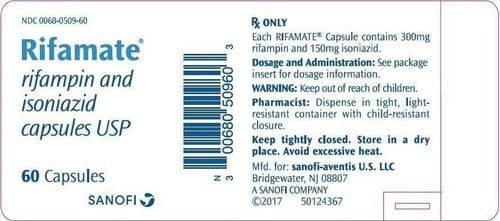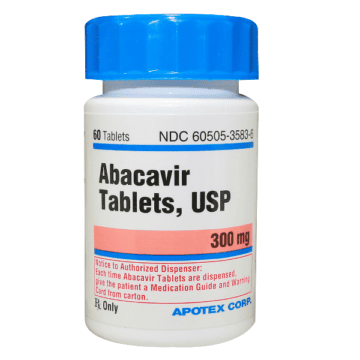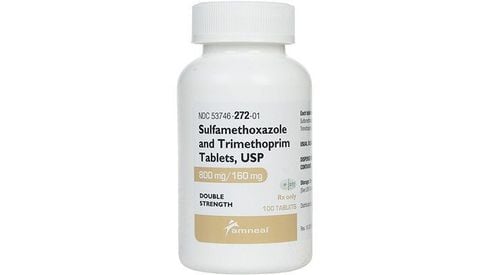This is an automatically translated article.
Zaniat drug is made in the form of tablets, with the main ingredient being Cefuroxime. The drug is used in the treatment of infections caused by bacteria sensitive to the active ingredient Cefuroxime.
1. Uses of Zaniat
Zaniat drug has the main ingredient is Cefuroxim with different strengths such as 125mg (Zaniat 125), 250mg (Zaniat 250), 500mg (Zaniat 500),... Cefuroxim is a second generation semi-synthetic cephalosporin antibiotic. Cefuroxim axetil As a precursor, it does not have an antibacterial effect by itself. It is hydrolyzed in the body under the action of esterase enzyme into Cefuroxime, so it has an effect. Cefuroxime kills bacteria that are in the growth and division stage by inhibiting bacterial cell wall synthesis. This active substance binds to penicillin-binding proteins, which are proteins involved in the composition of bacterial cell membranes, acting as enzymes that catalyze the final stage of cell wall synthesis. As a result, the synthesized cell wall will weaken and become unstable under the effect of osmotic pressure.
Like other 2nd generation cephalosporin antibiotics such as cefaclor, cefamandol, Cefuroxime has better activity against gram-negative bacteria than first-generation cephalosporin antibiotics but has a narrower spectrum of activity against gram-negative bacteria than other first-generation cephalosporin antibiotics. 3rd generation cephalosporin antibiotics. Besides, Cefuroxim is also effective against many gram-positive aerobic bacteria, most gram-negative bacteria and many gram-negative bacilli,... However, Cefuroxime has no effect on many gram-negative bacteria. used against some anaerobic bacteria such as Bacteroides fragilis.
Indications for the use of Zaniat:
Treatment of upper respiratory tract infections such as sinusitis, tonsillitis, otitis media, pharyngitis; Treatment of lower respiratory tract infections such as acute bronchitis, pneumonia, exacerbations of chronic bronchitis; Treatment of urinary - genital infections such as nephritis - pyelonephritis, cystitis, urethritis; Treatment of skin and soft tissue infections such as impetigo, boils, pyoderma; Treatment of gonorrhea, acute urethritis without complications caused by gonorrhea, cervicitis; Treatment of early Lyme disease, prevention of late stage Lyme disease in people 12 years of age and older. Contraindications to the use of Zaniat:
Patients with a history of allergy to cephalosporin antibiotics or other components of the drug; Patients allergic to beta-lactam antibiotics (penicillin, carbapenem, monobactam).
2. How to use and dose Zaniat
Usage: Orally. The patient should take the medicine with meals.
Dosage:
Adults and children over 12 years old: Ear - nose - throat infections (sinusitis, pharyngitis, otitis media): Use dose of 250mg or 500mg x 12 hours/time, treat for 10 days; Lower respiratory tract infections: Dose 250mg or 500mg x 12 hours, treatment for 10 days for exacerbations of chronic bronchitis, for 5 - 10 days for acute bronchitis with accompanying superinfection; Community-acquired pneumonia for outpatients: 500mg x 12 hours/time, treatment for 10-14 days; Skin and soft tissue infections, uncomplicated urinary tract infections: Use a dose of 250mg or 500mg x 12 hours/time, treat for 10 days; New Lyme disease: 500mg x 12 hours/time, treatment for 20 days; Children 6 - 12 years old: If infection of ear - nose - throat, dose 250mg x 12 hours/time, treatment for 10 days; Children 3 months - 6 years old: Do not use Zaniat tablet form, should use dosage form with more suitable concentration; Children under 3 months of age: There is no experience using Cefuroxime for this group of subjects; Patients with renal impairment: The safety and efficacy of Cefuroxime in patients with renal impairment are unknown. Because cefuroxime is primarily eliminated by the kidneys, the dose of cefuroxime may be reduced in patients with impaired renal function to compensate for the slower excretion than in subjects with normal renal function. Hemodialysis can also remove Cefuroxime; Hepatic impairment: There are no data available on the use of Zaniat in patients with hepatic impairment. *Note: There is no bioavailability equivalence between Cefuroxime tablets and oral suspension, so the two forms cannot be substituted based on the mg/mg conversion.
Overdose: When using Zaniat drug overdose, the patient may experience nausea, vomiting and diarrhea. Patients may even experience increased neuromuscular excitability and seizures, especially in patients with renal failure.
When dealing with overdose, consideration should be given to the possibility of overdose, drug interactions and unusual pharmacokinetics in the patient. The patient's respiratory tract should be protected, combined with ventilation and intravenous fluids. If the patient develops seizures, the drug should be discontinued immediately and anticonvulsant therapy may be instituted if clinically indicated. Hemodialysis can remove drugs from the blood, but most treatment is supportive and symptomatic.
Missed dose: When forgetting to take a dose of Zaniat, the patient should take it as soon as he remembers. However, if it is almost time for the next dose, the patient should skip the missed dose and continue with the original dosing schedule, without needing to take a double dose to make up for the missed dose.
3. Side effects of Zaniat
When using Zaniat, patients may experience some side effects such as:
Common: Diarrhea, skin rash; Uncommon: Anaphylaxis, Candida infection, neutropenia, leukopenia, eosinophilia, positive Coombs test, nausea, vomiting, urticaria, skin pruritus; Rare: Shock, hemolytic anemia, pseudomembranous colitis, Stevens - Johnson syndrome, erythema multiforme, toxic epidermal necrolysis, mild elevation of AST - AST - alkaline phosphatase - LDH - serum bilirubin concentration transient, cholestatic jaundice, acute renal failure, interstitial nephritis, urethral pain or bleeding, renal pain, urinary tract infection, uremia, increased serum creatinine, dysuria, vaginal candidiasis, inflammation vagina, vaginal itching and irritation, convulsions (if high doses are taken and kidney failure), agitation, headache, joint pain. Patients should notify their doctor on the day of the side effects they experience while using Zaniat so that appropriate intervention measures can be taken.
4. Be careful when using Zaniat
Before and during the use of Zaniat, the patient should note:
Use caution when using Zaniat in patients with a history of hypersensitivity to cephalosporins, penicillins or other drugs; Patients using Zaniat may experience hypersensitivity reactions with various manifestations such as: fever, redness, itching of the skin, urticaria, erythema multiforme, serum sickness-like reactions, Stevens - Johnson syndrome, toxic epidermal necrolysis syndrome, angioedema, anaphylactic reactions,...; Zaniat should be used with caution in patients allergic to beta-lactam antibiotics; Renal function should be checked in critically ill patients receiving maximum antibiotics; Caution when co-administering Zaniat with potent diuretics, cephalosporin antibiotics and aminoglycosides; Long-term use of Zaniat can cause superinfection; Zaniat can cause pseudomembranous colitis, so it should be used with caution in patients with a history of gastrointestinal disease, especially colitis; Some cephalosporin antibiotics (including cefuroxime) can cause seizures, especially in patients with impaired renal function who are not adjusted to reduce antibiotic dose. During the course of taking the drug, if there are symptoms of convulsions, the patient should stop taking the drug and use appropriate anti-epileptic drugs; The safety and efficacy of Cefuroxime axetil in pediatric patients under 3 months of age have not been established; Zaniat may affect diagnostic tests: positive Coombs test, determination of blood glucose levels,...; Care should be taken when driving or operating machinery, because Zaniat can cause side effects such as headache, dizziness; Animal studies have shown that Cefuroxime does not cause impaired fertility or harm to the fetus. The use of this antibiotic for the treatment of pyelonephritis in pregnant women has not shown adverse effects in the neonate after exposure to the drug in the mother's womb. Therefore, cephalosporins are considered safe to use during pregnancy. However, due to the lack of studies on the effectiveness and safety of the drug in pregnant women, the drug should only be used when absolutely necessary; Cefuroxime is excreted in human milk in low concentrations. Because the risk of adverse effects has not been assessed in nursing infants, Zaniat should only be used in nursing mothers after carefully weighing the risks and benefits and closely monitoring their health. of the baby during the mother's antibiotic use.
5. Zaniat . drug interactions
Some drug interactions of Zaniat include:
High-dose Probenecid reduces renal clearance of Cefuroxime, resulting in higher and longer plasma concentrations of Cefuroxime, increasing the effect of the drug; Concomitant use of cefuroxime with aminoglycoside antibiotics, cephalothin (first generation cephalosporin) or potent diuretics (furosemide) may increase nephrotoxicity; Cefuroxime axetil taken orally can affect the microflora of the intestine, reducing estrogen reabsorption. Therefore, the drug may reduce the effect of oral contraceptives containing estrogen and progesterone; Concomitant use of Cefuroxime with oral anticoagulants may increase blood clotting time. When prescribed to use Zaniat, patients should strictly follow the doctor's instructions on dosage and time of taking the drug to ensure the best treatment effect and minimize the risk of side effects. hazardous.
Follow Vinmec International General Hospital website to get more health, nutrition and beauty information to protect the health of yourself and your loved ones in your family.













